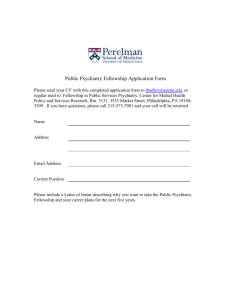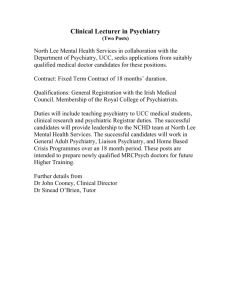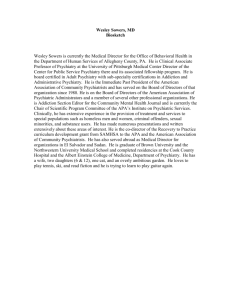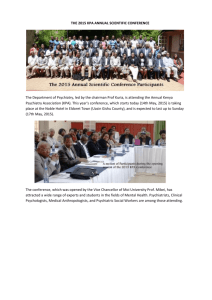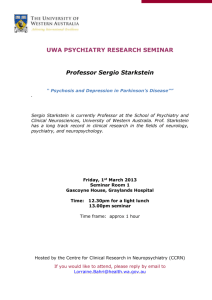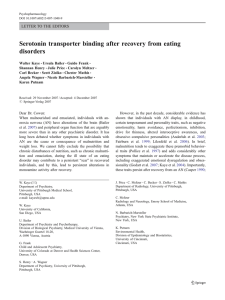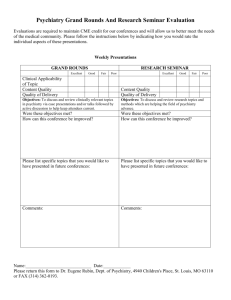VGLL4 gene in Characterization of genetic variation in the anorexia nervosa
advertisement
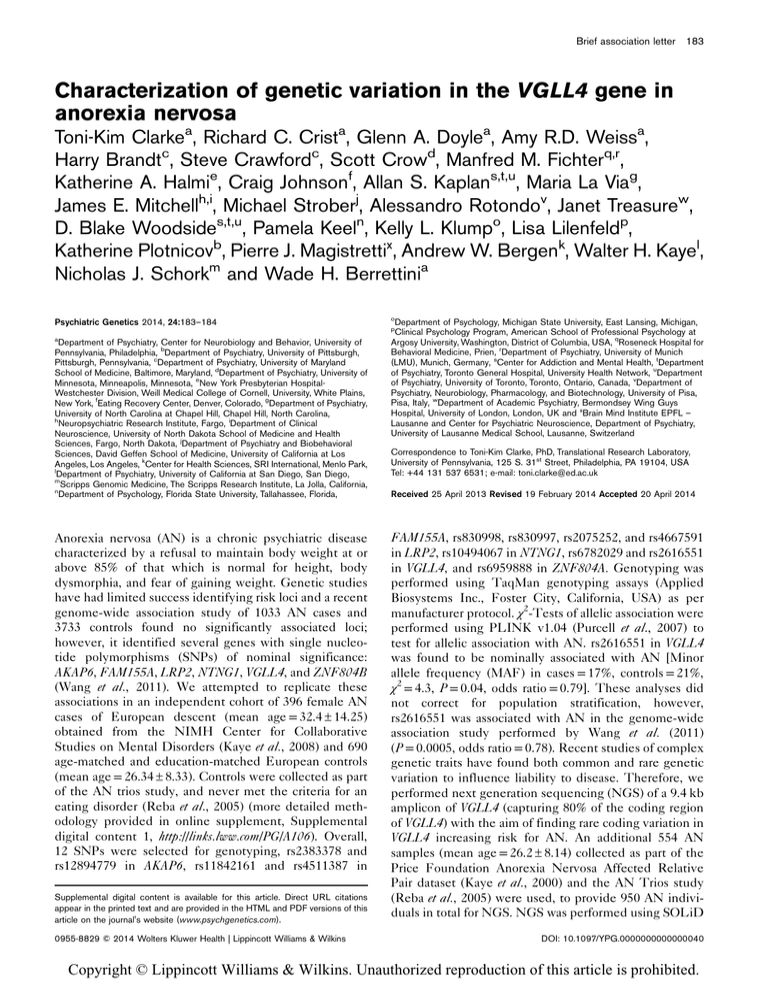
Brief association letter 183 Characterization of genetic variation in the VGLL4 gene in anorexia nervosa Toni-Kim Clarkea, Richard C. Crista, Glenn A. Doylea, Amy R.D. Weissa, Harry Brandtc, Steve Crawfordc, Scott Crowd, Manfred M. Fichterq,r, Katherine A. Halmie, Craig Johnsonf, Allan S. Kaplans,t,u, Maria La Viag, James E. Mitchellh,i, Michael Stroberj, Alessandro Rotondov, Janet Treasurew, D. Blake Woodsides,t,u, Pamela Keeln, Kelly L. Klumpo, Lisa Lilenfeldp, Katherine Plotnicovb, Pierre J. Magistrettix, Andrew W. Bergenk, Walter H. Kayel, Nicholas J. Schorkm and Wade H. Berrettinia Psychiatric Genetics 2014, 24:183–184 a Department of Psychiatry, Center for Neurobiology and Behavior, University of Pennsylvania, Philadelphia, bDepartment of Psychiatry, University of Pittsburgh, Pittsburgh, Pennsylvania, cDepartment of Psychiatry, University of Maryland School of Medicine, Baltimore, Maryland, dDepartment of Psychiatry, University of Minnesota, Minneapolis, Minnesota, eNew York Presbyterian HospitalWestchester Division, Weill Medical College of Cornell, University, White Plains, New York, fEating Recovery Center, Denver, Colorado, gDepartment of Psychiatry, University of North Carolina at Chapel Hill, Chapel Hill, North Carolina, h Neuropsychiatric Research Institute, Fargo, iDepartment of Clinical Neuroscience, University of North Dakota School of Medicine and Health Sciences, Fargo, North Dakota, jDepartment of Psychiatry and Biobehavioral Sciences, David Geffen School of Medicine, University of California at Los Angeles, Los Angeles, kCenter for Health Sciences, SRI International, Menlo Park, l Department of Psychiatry, University of California at San Diego, San Diego, m Scripps Genomic Medicine, The Scripps Research Institute, La Jolla, California, n Department of Psychology, Florida State University, Tallahassee, Florida, Anorexia nervosa (AN) is a chronic psychiatric disease characterized by a refusal to maintain body weight at or above 85% of that which is normal for height, body dysmorphia, and fear of gaining weight. Genetic studies have had limited success identifying risk loci and a recent genome-wide association study of 1033 AN cases and 3733 controls found no significantly associated loci; however, it identified several genes with single nucleotide polymorphisms (SNPs) of nominal significance: AKAP6, FAM155A, LRP2, NTNG1, VGLL4, and ZNF804B (Wang et al., 2011). We attempted to replicate these associations in an independent cohort of 396 female AN cases of European descent (mean age = 32.4 ± 14.25) obtained from the NIMH Center for Collaborative Studies on Mental Disorders (Kaye et al., 2008) and 690 age-matched and education-matched European controls (mean age = 26.34 ± 8.33). Controls were collected as part of the AN trios study, and never met the criteria for an eating disorder (Reba et al., 2005) (more detailed methodology provided in online supplement, Supplemental digital content 1, http://links.lww.com/PG/A106). Overall, 12 SNPs were selected for genotyping, rs2383378 and rs12894779 in AKAP6, rs11842161 and rs4511387 in Supplemental digital content is available for this article. Direct URL citations appear in the printed text and are provided in the HTML and PDF versions of this article on the journal's website (www.psychgenetics.com). 0955-8829 © 2014 Wolters Kluwer Health | Lippincott Williams & Wilkins o Department of Psychology, Michigan State University, East Lansing, Michigan, Clinical Psychology Program, American School of Professional Psychology at Argosy University, Washington, District of Columbia, USA, qRoseneck Hospital for Behavioral Medicine, Prien, rDepartment of Psychiatry, University of Munich (LMU), Munich, Germany, sCenter for Addiction and Mental Health, tDepartment of Psychiatry, Toronto General Hospital, University Health Network, uDepartment of Psychiatry, University of Toronto, Toronto, Ontario, Canada, vDepartment of Psychiatry, Neurobiology, Pharmacology, and Biotechnology, University of Pisa, Pisa, Italy, wDepartment of Academic Psychiatry, Bermondsey Wing Guys Hospital, University of London, London, UK and xBrain Mind Institute EPFL – Lausanne and Center for Psychiatric Neuroscience, Department of Psychiatry, University of Lausanne Medical School, Lausanne, Switzerland p Correspondence to Toni-Kim Clarke, PhD, Translational Research Laboratory, University of Pennsylvania, 125 S. 31st Street, Philadelphia, PA 19104, USA Tel: +44 131 537 6531; e-mail: toni.clarke@ed.ac.uk Received 25 April 2013 Revised 19 February 2014 Accepted 20 April 2014 FAM155A, rs830998, rs830997, rs2075252, and rs4667591 in LRP2, rs10494067 in NTNG1, rs6782029 and rs2616551 in VGLL4, and rs6959888 in ZNF804A. Genotyping was performed using TaqMan genotyping assays (Applied Biosystems Inc., Foster City, California, USA) as per manufacturer protocol. χ2-Tests of allelic association were performed using PLINK v1.04 (Purcell et al., 2007) to test for allelic association with AN. rs2616551 in VGLL4 was found to be nominally associated with AN [Minor allele frequency (MAF) in cases = 17%, controls = 21%, χ2 = 4.3, P = 0.04, odds ratio = 0.79]. These analyses did not correct for population stratification, however, rs2616551 was associated with AN in the genome-wide association study performed by Wang et al. (2011) (P = 0.0005, odds ratio = 0.78). Recent studies of complex genetic traits have found both common and rare genetic variation to influence liability to disease. Therefore, we performed next generation sequencing (NGS) of a 9.4 kb amplicon of VGLL4 (capturing 80% of the coding region of VGLL4) with the aim of finding rare coding variation in VGLL4 increasing risk for AN. An additional 554 AN samples (mean age = 26.2 ± 8.14) collected as part of the Price Foundation Anorexia Nervosa Affected Relative Pair dataset (Kaye et al., 2000) and the AN Trios study (Reba et al., 2005) were used, to provide 950 AN individuals in total for NGS. NGS was performed using SOLiD DOI: 10.1097/YPG.0000000000000040 Copyright © Lippincott Williams & Wilkins. Unauthorized reproduction of this article is prohibited. 184 Psychiatric Genetics 2014, Vol 24 No 4 4 sequencing (Life Technologies, Grand Island, New York, USA) at the Penn Genome Frontiers Institute. Sequence reads were aligned to the reference sequence for VGLL4 (build hg19) using Bowtie (version 0.12.7) (Langmead et al., 2009), SAMtools (version 0.1.18), and VarScan (version 2.2.7). A total of 59 variants were identified and 40 of these were novel. Only one SNP was coding (synonymous), and therefore none of the 59 variants were genotyped in additional AN populations. This should be considered a limitation of this study as noncoding variation is known to influence disease risk. However, because of the nominal association of VGLL4 in two independent AN cohorts, this remains a candidate gene worthy of future study in AN populations. Acknowledgements This work was supported by grants from the Klarman Family Foundation, the Price Foundation and the Hilda & Preston Davis Foundation. The data and collection of biomaterials for the Genetics of Anorexia Nervosa study have been supported by the National Institutes of Health Grants (MH066122, MH066117, MH066145, MH066289, MH066193, MH066146). MH066296, MH066287, MH066147, MH066288, Conflicts of interest There are no conflicts of interest. References Kaye WH, Lilenfeld LR, Berrettini WH, Strober M, Devlin B, Klump KL, et al. (2000). A search for susceptibility loci for anorexia nervosa: methods and sample description. Biol Psychiatry 47:794–803. Kaye WH, Bulik CM, Plotnicov K, Thornton L, Devlin B, Fichter MM, et al. (2008). The genetics of anorexia nervosa collaborative study: methods and sample description. Int J Eat Disord 41:289–300. Langmead B, Trapnell C, Pop M, Salzberg SL (2009). Ultrafast and memoryefficient alignment of short DNA sequences to the human genome. Genome Biol 10:R25. Purcell S, Neale B, Todd-Brown K, Thomas L, Ferreira MA, Bender D, et al. (2007). PLINK: a tool set for whole-genome association and populationbased linkage analyses. Am J Hum Genet 81:559–575. Reba L, Thornton L, Tozzi F, Klump KL, Brandt H, Crawford S, et al. (2005). Relationships between features associated with vomiting in purging-type eating disorders. Int J Eat Disord 38:287–294. Wang K, Zhang H, Bloss CS, Duvvuri V, Kaye W, Schork NJ, et al. (2011). A genome-wide association study on common SNPs and rare CNVs in anorexia nervosa. Mol Psychiatry 16:949–959. Copyright © Lippincott Williams & Wilkins. Unauthorized reproduction of this article is prohibited.

